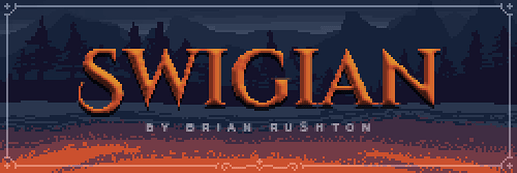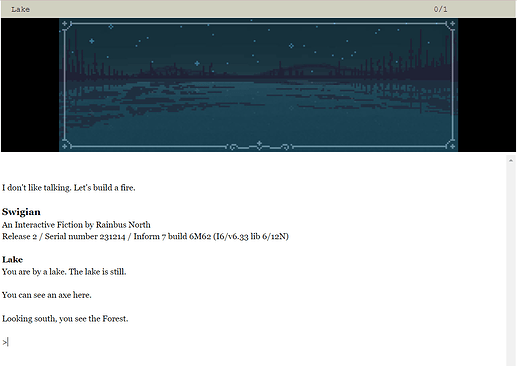For the last few games, I’m going to just do one game at a time, so I can finish on October 30th (and not run into Ectocomp).
Swigian
This game, I think, succeeds in its goal.
This is the last of my pseudonym shenanigan games. I had noticed a pattern in IFComp winners (and high-placers) over the years: they were all (before Twine) long, polished, parser games that weren’t repetitive. And no game like that placed low. Genre didn’t matter, writing quality didn’t seem to matter (outside of typos), puzzles didn’t matter, and so on.
So I decided to test my experiment by making a ‘fake game’. I’d create a minimalist parser game that lasted 200 moves (the approximate amount many IFComp winners last), and which never repeated large chunks of action, but otherwise had as little content as possible.
I made a forest with an axe where you chop wood, and find a flint for a fire. I think I was thinking in Minecraft terms. But then it was hard to come up with a concept, so I decided to throw in some Scandinavian mythology to theme it all together.
I put it under a pseudonym (Rainbus North, an anagram of Brian Rushton) and watched. I also had my ‘real game’ in the competition, Absence of Law. That game was at least 4 times larger and had been very carefully crafted.
I was amused, shocked, and intrigued by early reviews; it honestly seemed at first that Swigian was receiving at least as popular a reception as Absence of Law! I was especially shocked to see many of the avant-garde authors (who I respected but who hadn’t liked my main work) say they enjoyed Swigian, which was really nice.
In the end, though, it did in fact place 21st, while Absence of Law was 4th. 21st place definitely isn’t bad, but it showed that my hypothesis is wrong: it’s not enough to just have non-repetitive content, you need something more.
I liked the gameplay on replay just now, but not as much as my other last few games on the list. I think the atmosphere is fun, and I love the graphics. Marco Innocenti very kindly volunteered to make graphics for each location, which seriously improved the game so much; I’d say that the appeal of the current version of the game is, to me, 40% graphics and 60% games.
I’ve shared Swigian with middle school students studying Beowulf, where it’s been fairly popular (usually one or two kids will get obsessed with it but struggle since its parser, so they get hints until it’s done). I also rewrote it in Adventuron to learn the language, which was a fun exercise.
So yeah, I don’t have a lot of strong feelings about Swigian. It was a fun experiment that Marco Innocenti beautified, and I’m happy with where it places in my list of games and with its overall reception.

